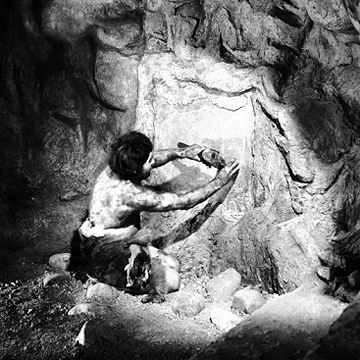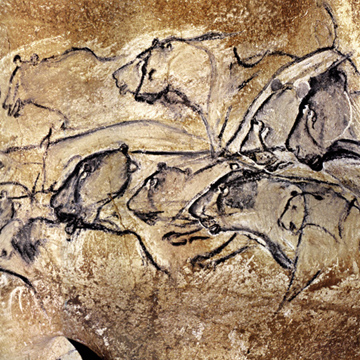 |
 |
The Descent into the Cave by Dr. Ilse Vickers
|
Page 1/5 |
When Upper Palaeolithic man (ca 40,000 BC - ca 10,000 BC) took upon himself the perilous descent into the caves of Southern France and Northern Spain, and braved dangerous passageways, piercing cold, impenetrable darkness and total silence for the purpose of
painting the rock-face with images of the animal kingdom, he could not possibly have foreseen that tens of thousands of years later men and women would still view these paintings and be awe-struck by their majestic, mysterious beauty. We are far removed from the image makers of the Ice Age and it is impossible to say with certainty what made them undertake these dark and dangerous journeys, or, indeed, what thoughts and beliefs motivated them to place the images in the innermost, darkest recesses of the caves. By approaching Upper Palaeolithic cave art from the point of view of depth psychology, it is hoped that light may be thrown on some of these baffling questions. In order to prepare the ground, it will be necessary, first, to say something about the two spheres of the psyche, that is, the conscious and the unconscious, and about the dynamic relationship between the two, and second, to highlight some of the similarities and differences that there are thought to exist between the so-called 'primitive' mentality and modern man's state of consciousness.
As human beings we all belong to the same species,
homo sapiens - or, to be more precise, to the species of
homo sapiens sapiens - and as such we share a deep psychic experience which the Swiss psychologist, Carl Gustav Jung, termed 'the collective unconscious'. Like our common human anatomy, the unconscious mind has its history and comprises an immense storehouse of memories dating back to the distant past. Again, like the human body the collective unconscious transcends all cultural and racial differences and forms (together with the conscious mind) a boundless, indefinable totality reaching far beyond human comprehension.
The totality of the conscious and unconscious psyche is a primordial and abstract concept similar to Kant's 'Ding an sich': whilst we are able to elucidate some aspects, the totality will always transcend the limits of human knowledge. 'Such being the case', writes Jung, 'we should not be in the least surprised if the empirical manifestations of unconscious contents bear all the marks of something illimitable, something not determined by space and time' , in short, something that has the quality of the numinous or divine.
The existence of a common psychic substratum explains why analogous mythological motifs and symbols can be found in religions of all ages and in places very far apart. The point is that these archetypal patterns (such as, for example, the motif of the death and resurrection of the hero, or the symbol for wholeness as represented by the mandala) have not been made by man, nor are they in the first instance due to diffusion, cultural influences or education. Instead, such constellations of ideas have over an immense period of time evolved and become rooted in the depth of the human psyche from where they spontaneously arise even - or perhaps especially - when the conscious mind is inactive and in need of introspection. All our conscious actions, thoughts, imaginations and religious practices have developed from the substratum of these unconscious archetypal images, and they will always remain connected with them.
Viewing the decorated caves of the Palaeolithic period, we may perhaps be tempted to think of these early artists as 'them' versus 'us', the 'primitive' as contrasted to the 'modern' man. Such simple distinctions are, however, deceptive because as
homo sapiens we not only have the same psychic substratum but also the same brain structure. The supposition therefore that so-called 'primitive' man thought or experienced his world in a way that was significantly different from us is not based on fact. True, our consciousness is far more developed than that of our forebears and we may justifiably think of ourselves as modern. All the same, we cannot escape the fact that there is another life in us, one that from our higher but lopsided rational position we either cannot or no longer want to see: our prehistoric past. According to Jung, 'every civilized human being, however high his conscious development, is still an archaic man at the deeper levels of his psyche.' This being the case, what is it then that distinguishes our psychology from that of Ice-age man?
It is not easy in the short space available here to do justice to this wide-ranging question. Briefly, in primitive man the conscious mind is as yet hardly differentiated from the unconscious. We assume that he still lives in a primordial state and in total harmony with his surroundings; he is so tuned in that he can hear the 'voice' of his mountains, his woods, his rivers, etc., and know, for example, when the weather will turn long before it actually happens. Primitive man still has what the French philosopher Levy-Bruhl (1857-1939) termed, a participation mystique, a mystical relationship or identification with his world. As studies into primitive societies that have survived to the present have shown, primitive man is convinced that not only human beings but animals and even objects have a spirit, a soul or a voice, and that all he has to do, is find the right wood, the right piece of land, or rock, etc., and he will hear the voice. Unlike modern man who has learnt to differentiate between the subjective and the objective, primitive man is unable to make such a distinction; for him the subjective and the objective are fused in the external world. In the face of something extraordinary he will be unable to withdraw his emotions from the place or event and instead will invest the situation with the power to shock, to astonish, etc.
According to Jung, the characteristic which primarily distinguishes primitive man is his attitude to nature, particularly to the chance occurrences in nature. For primitive man, any extraordinary event or place, far from being a mere accident, was construed as an auspicious occurrence in which 'the eternal spirits stepped across the threshold' and spoke with mana, that is, with supernatural power and wilful intent. Looking back from our position of greater psychic differentiation, it is all too easy to dismiss our ancestors' attitude to accidents of nature as irrational and superstitious, but for primitive man for whom everything was significant, the belief in the power of chance was entirely natural and logical. His mind was still unaware of any possible scientific explanation and if he came across such arbitrary creations of nature as for instance '
Le Pont d'Arc' across the river Ardeche (a huge natural stone bridge), or the nearby underground
cave of Chauvet (a most impressive underground cavern), he may well have felt himself to be in the presence of the numinous, the holy 'mysterium tremendum et fascinans' (Rudolf Otto, 1869-1937); he would have felt diminished and his response most likely would have been one of profound terror and of awe. Nor, it must be observed, is it only primitive man who responds in this way to the mystery of naturally created caves - at the deepest levels of our being we are still archaic and connected to the past - as the philosopher Seneca writing in the 1st century AD so eloquently reminds us:
'If ever you have come upon ..... a cave, made by the deep crumbling of rocks, holds up a mountain on its arch, a place not built with hands but hollowed-out into such spaciousness by natural causes, your soul will be deeply moved by a certain intimation of the existence of God'.
Similarly, the German poet-philosopher Goethe (1749-1832) declared in his greatest work, Faust, that in the response to the mysterium tremendum is revealed the best aspect of humanity, namely man's aspirations mixed with humility and awe.
'Das Schaudern ist der Menschheit bestes Teil;
Wie auch die Welt ihm has Gefuehl verteure,
Ergriffen, fuehlt er tief das Ungeheure'. (that is, the 'tremendum')
Many modern explorers of Palaeolithic caves have reported that when they had reached the extremes of the cave, that is, when they had reached a point where their intellectual navigational tools had become useless, they had suddenly found themselves under the spell of irrational fears, prompting atavistic feelings. Moreover, with their senses, as it were, switched off, it seemed to them that they were looking inwards as if seeing with an 'inner eye'.
A descent into the deep underground cave is a journey to a most remote land where to the seeker with the right mind-set, the door to the numinous may to be found. From a purely psychological point of view, one could describe the descent into the underground caverns as at once an actual, physical journey as well as an inner journey; the descent without corresponds to the descent within. With every step downwards, one travels back in time, sheds layer after layer of human history until one arrives at a mysterious place beyond duality and outside rational explanation. It is a place where all differentiations between the known and the intuitively felt become blurred, where one flows into the other, and miraculously becomes the other. Not surprisingly, Jung described the psycho-physical journey as 'a blissful and terrible experience'; as 'eine Hoellenfahrt in die Zukunft', a hellish journey into the future.
Further Reading:
→
Cave Art: An Intuition of Eternity
→
Dr. Ilse Vickers
→
Bradshaw Foundation Homepage
→
French Cave Paintings & Rock Art Archive















